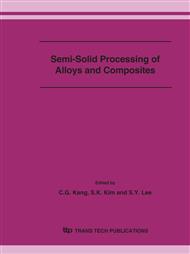[1]
P. F. Mendez, C. S. Rice, and S. B. Brown: Joining Using Semisolid Metals, Welding Journal, Sep. (2002), pp. 181s-187s.
Google Scholar
[2]
Flemings, M. C.: Behavior of metal alloys in the semisolid state, Metallurgical Transactions B Vol. 22B (1991), pp.269-293.
DOI: 10.1007/bf02651227
Google Scholar
[3]
M. Kiuchi, J. Yanagimoto, S. Sugiyama: Application of Mushy / Semisolid Joining - Part 2, Proceeding of 7th conference on semisolid processing of alloys and composites (2000).
Google Scholar
[4]
R. Kopp, J. Kallweit, T. Möller, I. Seidl: Forming And Joining of Commercial Steel Grades in the Semisolid State, Journal of Material Processing Technology Vol. 130-131 (2002), pp.562-568.
DOI: 10.1016/s0924-0136(02)00766-5
Google Scholar
[5]
M. Kiuchi, Yangagimoto, Sugiyama: Application of Mushy/Semisolid Joining - part 3, Journal of Materials processing Technology Vol. 140 (2003), pp.163-166.
DOI: 10.1016/s0924-0136(03)00705-2
Google Scholar
[6]
H.W. Liu, C. Guo, Y. Cheng, X.F. Liu, and G.J. Shao: Interfacial Strength and Structure of Stainless Steel-Semi-solid Aluminum Alloy Clad Metal, Materials Letters Vol. 60 (2006), pp.180-184.
DOI: 10.1016/j.matlet.2005.08.015
Google Scholar
[7]
K.P. Young, C.P. Kyonka, J.A. Courtois: United States patent No. 4, 415, 374 (1983).
Google Scholar
[8]
E.A. Vieira, M. Ferrante: Prediction of Rheological Behavior and Segregation Susceptibility of Semi-Solid Aluminum-Silicon Alloys by a Extrusion Test, Acta Materialia (2005), pp.5379-5386.
DOI: 10.1016/j.actamat.2005.08.014
Google Scholar
[9]
R.K. Guduru, K.A. Darling, R. Kishore, R.O. Scattergood, C.C. Koch, K.L. Murty: Evaluation of mechanical properties using shear-punch testing, Materials Science and Engineering A Vol. 395 (2005), pp.307-314.
DOI: 10.1016/j.msea.2004.12.048
Google Scholar
[10]
M. Amirizad, A.H. Kokabi, M. Abbasi Gharacheh, R. Sarrafi, B. Shalchi and M. Azizieh: Evaluation of microstructure and mechanical properties in friction stir welded A356 + 15%SiCp cast composite, Materials Letters, Vol. 60, Issue 4, Feb. (2006).
DOI: 10.1016/j.matlet.2005.09.035
Google Scholar
[11]
C.A. Leon and R.A.L. Drew: Review of small specimen test techniques for irradiation testing, Mater. Let. Vol. 56 (2002) pp.812-816.
Google Scholar
[12]
G.E. Lucas: Review of small specimen test techniques for irradiation testing, J Metal. Trans. A Vol. 21A (1990), pp.1105-1116.
Google Scholar


